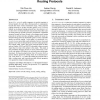302 search results - page 44 / 61 » Using Attack Injection to Discover New Vulnerabilities |
CCS
2008
ACM
13 years 10 months ago
2008
ACM
Cross-Site Request Forgery (CSRF) is a widely exploited web site vulnerability. In this paper, we present a new variation on CSRF attacks, login CSRF, in which the attacker forges...
SRDS
2006
IEEE
14 years 1 months ago
2006
IEEE
The web is a complicated graph, with millions of websites interlinked together. In this paper, we propose to use this web sitegraph structure to mitigate flooding attacks on a we...
ESORICS
2007
Springer
14 years 2 months ago
2007
Springer
Port knocking is a technique first introduced in the blackhat and trade literature to prevent attackers from discovering and exploiting potentially vulnerable services on a networ...
WS
2003
ACM
14 years 1 months ago
2003
ACM
In an ad hoc network, mobile computers (or nodes) cooperate to forward packets for each other, allowing nodes to communicate beyond their direct wireless transmission range. Many ...
SP
2008
IEEE
14 years 2 months ago
2008
IEEE
Attacks often exploit memory errors to gain control over the execution of vulnerable programs. These attacks remain a serious problem despite previous research on techniques to pr...

